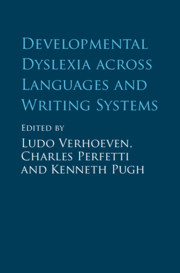Book contents
- Developmental Dyslexia across Languages and Writing Systems
- Developmental Dyslexia across Languages and Writing Systems
- Copyright page
- Contents
- Figures
- Tables
- Contributors
- 1 Introduction
- Part I Developmental Dyslexia across Languages and Writing Systems
- 2 Developmental Dyslexia in English
- 3 Developmental Dyslexia in French
- 4 Developmental Dyslexia in Dutch
- 5 Developmental Dyslexia in Czech and Slovak
- 6 Developmental Dyslexia in Finnish
- 7 Developmental Dyslexia in Russian
- 8 Developmental Dyslexia in Hebrew
- 9 Developmental Dyslexia in Japanese
- 10 Developmental Dyslexia in Chinese
- Part II Cross-Linguistic Perspectives on Developmental Dyslexia
- Epilogue
- Index
- References
7 - Developmental Dyslexia in Russian
from Part I - Developmental Dyslexia across Languages and Writing Systems
Published online by Cambridge University Press: 27 September 2019
- Developmental Dyslexia across Languages and Writing Systems
- Developmental Dyslexia across Languages and Writing Systems
- Copyright page
- Contents
- Figures
- Tables
- Contributors
- 1 Introduction
- Part I Developmental Dyslexia across Languages and Writing Systems
- 2 Developmental Dyslexia in English
- 3 Developmental Dyslexia in French
- 4 Developmental Dyslexia in Dutch
- 5 Developmental Dyslexia in Czech and Slovak
- 6 Developmental Dyslexia in Finnish
- 7 Developmental Dyslexia in Russian
- 8 Developmental Dyslexia in Hebrew
- 9 Developmental Dyslexia in Japanese
- 10 Developmental Dyslexia in Chinese
- Part II Cross-Linguistic Perspectives on Developmental Dyslexia
- Epilogue
- Index
- References
Summary
This chapter provides an overview of studies of (a)typical reading acquisition in Russian. Although it is titled “Developmental Dyslexia in Russian” by the editors of the volume, its scope is much wider; this is due to the circumstance that there is no consensus definition of dyslexia in Russian scientific studies of reading, nor are such studies voluminous. Russians have been referred to as “the most reading nation on Earth” (Voice of America, 2010), based on the levels of literacy in the general population, the time spent by an average person reading, and the promotion of reading as a cultural activity. That is one of the reasons why, perhaps, the problem of atypical reading acquisition has not been at the forefront of cognitive and educational psychology in Russia. However, there is nonetheless a tradition of relevant research, of which this chapter provides an overview.
- Type
- Chapter
- Information
- Developmental Dyslexia across Languages and Writing Systems , pp. 133 - 151Publisher: Cambridge University PressPrint publication year: 2019
References
- 6
- Cited by



